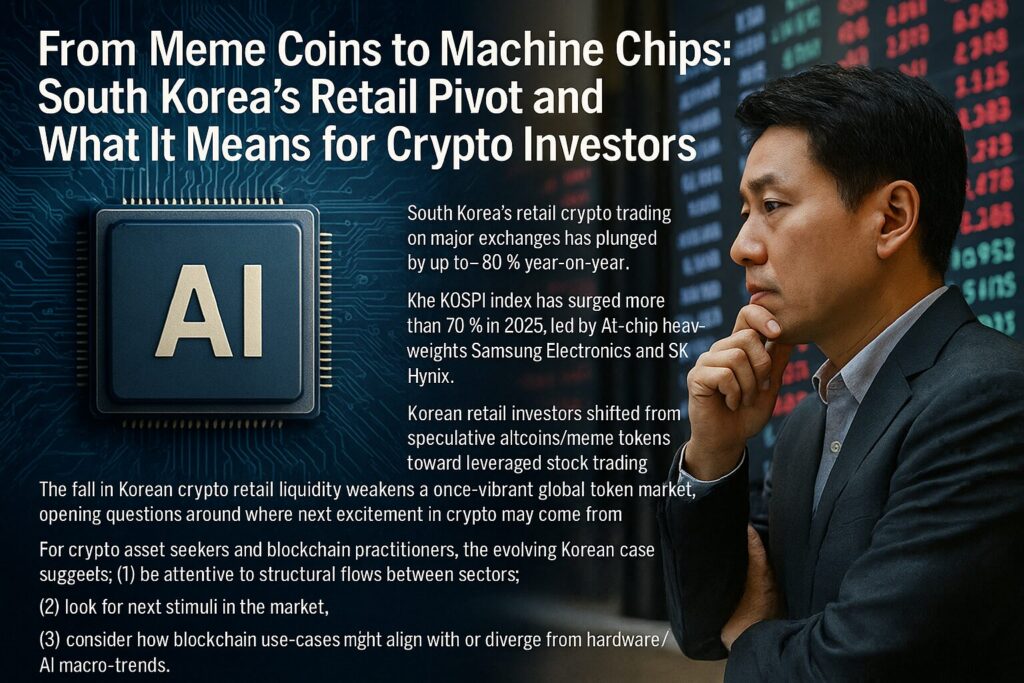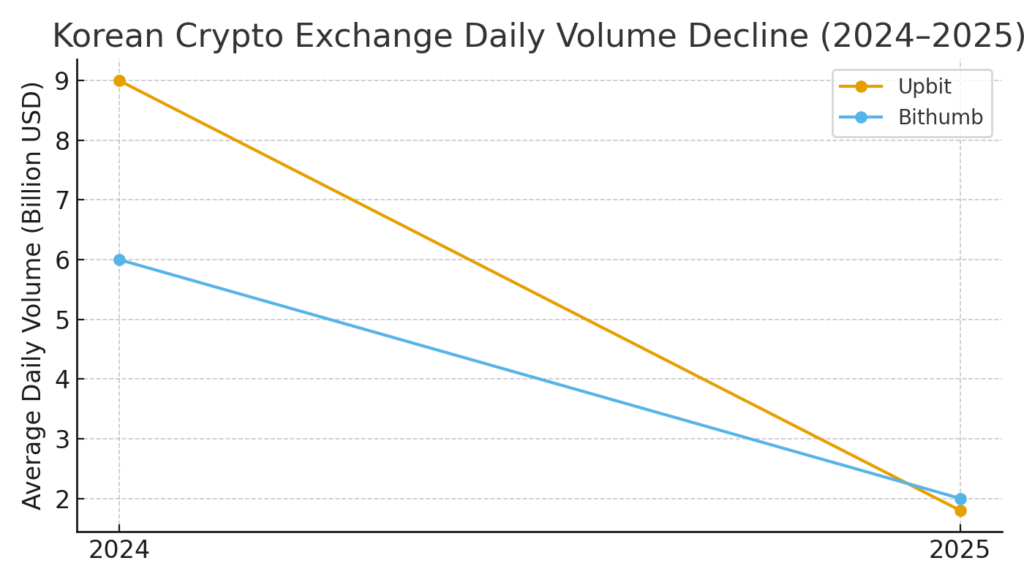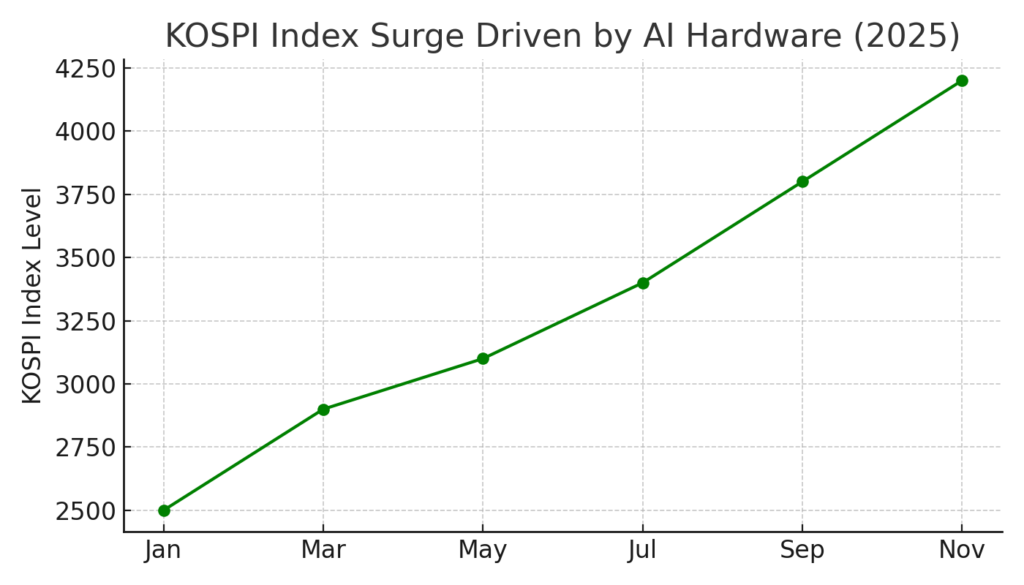
Main Points :
- South Korea’s retail crypto trading on major exchanges has plunged by up to ~80 % year-on-year.
- The KOSPI index has surged more than 70 % in 2025, led by AI‐chip heavyweights such as Samsung Electronics and SK Hynix.
- Korean retail investors have shifted from speculative altcoins/meme tokens toward leveraged stock trading and AI hardware equities.
- The fall in Korean crypto retail liquidity weakens a once-vibrant global token market, opening questions around where next excitement in crypto may come from.
- For crypto asset seekers and blockchain practitioners, the evolving Korean case suggests: (1) be attentive to structural flows between sectors; (2) look for next stimuli in the market; (3) consider how blockchain use-cases might align with or diverge from hardware/AI macro-trends.
1. The Quieting of Korean Crypto Markets

In recent years, South Korea was often spotlighted as one of the most enthusiastic retail crypto markets in the world: domestic exchanges had high volumes, local retail adoption was strong, and speculative altcoins and meme tokens flourished. However, according to recent reporting by Coindesk, that era appears to have sharply subsided — the country’s major exchanges such as Upbit and Bithumb saw retail trading volumes fall by as much as 80 % year-on-year.
Earlier estimates had forecast that Korean-won-denominated crypto trading would reach US$ 663 billion in 2025, second only to USD-denominated markets. Yet this top‐down statistic obscures the retail participation collapsing, liquidity drying up and volatility shrinking. In one summer slowdown report, Korea’s daily crypto trade shrank to US$ 2.55 billion – a 20 % decline in one day and showing the changed mood.
For crypto asset hunters and blockchain technologists, this signals a shift: one major regional engine of crypto speculation has cooled, thus reducing one source of upside flows. Understanding where this liquidity is migrating is therefore important.
2. The Surge in AI Hardware and Korean Equity Fervour

Meanwhile, something else in South Korea took over the speculative limelight: the domestic stock market, driven by the country’s leadership in AI‐chip hardware. The KOSPI index is up more than 70 % year-to-date in 2025.
Key to that rise are Samsung Electronics and SK Hynix, both major global players in high bandwidth memory (HBM) and other AI hardware components. SK Hynix alone forecasts the AI-memory market will grow ~30 % per year through 2030.
This hardware boom has created a landscape where retail investors who previously chased altcoins/meme projects are now piling into semiconductor equities and leveraged stock products. Data show that the number of active trading brokerage accounts in Korea rose from 86.57 million at the start of 2025 to 95.33 million by October 31.
Thus: the psychology of speculation remains; the object of speculation simply changed. Instead of chasing the next token with viral meme potential, the crowd is chasing chip secular growth, AI tailwinds, and stock momentum.
3. What’s Behind the Rotation?

A. Structural market dynamics
One reason for the rotation is that, while crypto markets often offer high potential upside, they also suffer from high risk, regulatory pressure, and declining retail exuberance. In contrast, the hardware/AI sector in Korea presents a more tangible growth story with strong fundamentals: huge demand from global AI data‐centres, memory scarcity, and a dominant domestic supply chain.
B. Government and policy tailwinds
South Korea’s government under President Yoon Suk‑yeol has pushed reforms to strengthen corporate governance, increase dividends, and incentivise domestic investment – all of which helped the equity market.
C. Retail risk appetite re-channeled
Retail traders still crave the “casino-like” thrill of speculation, but the vehicle has changed. Margin trading, leveraged ETFs, and high-turnover equities became the new frontier rather than speculative tokens. The effect is that liquidity which might once have gone into altcoins is now directed into equities.
D. Crypto’s losing anchor
As the Korean retail crypto market quiets, the global token ecosystem loses one of its most enthusiastic participant bases — the so-called “kimchi premium” environment. The drop in volatility, the drop in speculative accounts, and the muted altcoin activity all point to that reduction in anchor liquidity. For crypto investors and builders, this means the market may experience lower tailwinds from Korea going forward.
4. Implications for Crypto Investors and Blockchain Builde
For New Crypto Asset Seekers
- The cooling of one major retail base emphasises the need to find new regional engines of token demand or to rely on broader institutional flows rather than pure retail hype.
- Blockchain projects should ask: if Korea’s retail capital shifts out of tokens, what region, use-case, or theme might pick up the slack? Possibly emerging markets, DeFi infrastructure, or AI-token synergy.
- Token launches will need stronger utilities, deeper use-case anchors, and less reliance on meme/token speculation, given the changing investor mindset.
For Practical Blockchain Application Developers
- The shift to hardware/AI emphasises that infrastructure matters: memory chips, AI data-centres, high-bandwidth architectures. Blockchain builders could consider how tokenised infrastructure, on-chain hardware supply-chain tracking, or AI/ML + chain integration might fit.
- While Korea’s speculative token market cooled, the underlying hardware boom still offers blockchain adjacency: e.g., tokenising memory supply chains, using smart contracts for wafer supply logistics, or enabling decentralised compute tied to hardware expansion.
- The rotation also suggests that investor attention can move swiftly: being alert to next theme (e.g., Web3 + AI + hardware) may help blockchain projects align with macro flows.
For Crypto Revenue & Token-Economy Strategists
- Token revenue models should factor in that national/regional retail liquidity can ebb or pivot like we observe in Korea. Thus, relying on one region’s enthusiasm is risky.
- Diversify: combine utility (payments, staking, governance) with deeper macro themes (AI, infrastructure, enterprise blockchain) which may hold investor attention even when retail hype fades.
- Monitor adjacent sectors: when hardware bulls are hot (as in Korea now), tokens that link to that hardware or supply-chain may capture spill-over interest.
5. What Comes Next? Potential Triggers and Risks
- If the AI/hardware wave cools, Korean retail investors may pivot back into crypto or another hot asset class. The article suggests that the “kimchi”-speculation spirit may not vanish forever.
- On the crypto front, Korea’s regulatory environment is evolving: institutional entry, ETFs, corporate real-name accounts are being hinted at which could bring a new wave of participation.
- Risk: the Korean hardware rally could form a bubble (some reports suggest concern about AI over-exuberance). If that pops, speculative capital may flood once again into crypto, causing token markets to surge.
- Another risk: with retail moving to equities, token projects may face talent, attention, and capital competition from adjacent sectors (AI, chips) instead of from within crypto.
6. Summary and Take-away
In South Korea, one of the world’s most dynamic retail investment landscapes, we are witnessing an important rotation: from speculative meme-coins and altcoins to AI-hardware and semiconductor equities. The shift shows that retail investor appetite has not disappeared — it has simply been redirected toward a more tangible growth story. For the global crypto community, this means a major regional investor base has away from tokens and toward stocks.
For token seekers and blockchain builders, the Korean case offers three key insights. First: investor flows are theme-driven and can pivot; token strategies should account for that. Second: adjacent technology themes (AI, hardware, supply chain) may offer better alignment for blockchain use-cases than pure speculation alone. Third: the next big wave may come when retail capital rediscovers crypto — building infrastructure, use-cases or token models that are ready for that re-entry may give you an edge.
In conclusion: the Korean pivot from meme-coins to machine chips is not just a local market story — it is a microcosm of how speculative investment attention can migrate across asset classes. As you scan for the next crypto asset or blockchain application, keep in mind that the next tailwind may come not just from inside crypto, but from the cross-pollination of sectors: hardware, AI, tokens, and investor psychology. Aligning your token economy, blockchain build-out and go-to-market strategy to reflect these macro flows will help you be ahead of the rotation — rather than chasing it.

